Say Cheese
I spent my birthday money on a cheese making kit. A step or two up from the single-batch gift boxes, it was an entry-level hobbyist setup with all the basic hardware and enough enzyme and rennet for a dozen or so batches, recipes included for six different types of cheese.
Cheese making is great fun. It is also time consuming (at least it requires several minutes of doing at intervals over a 24-hour period, frequently in the first 3 hours) and very much makes one appreciate the per-pound price of quality cheese. I have yet to try an aged cheese. I decided to stick to mozzarella for a whole year to hone my skills at that before branching out. Five batches in now.
The wheel pictured below was my third batch. Second batch was fresh mozzarella, enjoyed on County Foodshed Day.
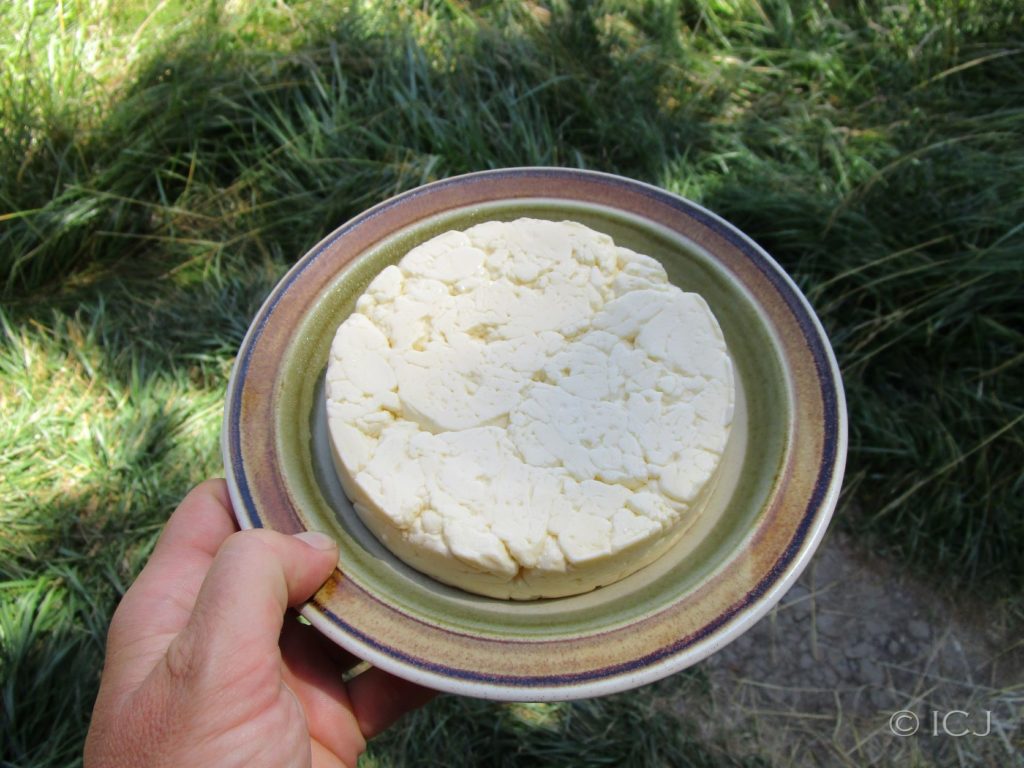
It takes a gallon of milk to make a pound of cheese. Afterwards one is left with three quarts of whey, which is a bit of an acquired taste, not because it’s unpleasant but because if one is expecting milk it tastes off. It’s not quite juice either. Somewhere in the kombucha and kefir realm but entirely its own self. I’ve come to enjoy it and find it best cold.
At $10 a gallon for farm-fresh raw milk, I am not saving money on the $5-$10 a pound that I usually spend on cheese at Grocery Outlet and Trader Joe’s. Unlike some things homemade or homegrown, the taste while pleasant and decidedly ‘fresh’ is thus far not superior to a respectable grocery store cheese, and this is certainly not the fault of the milk. I’m hoping with practice that’ll change. The fresh curds are the exception. The curds, once they have drained for the requisite 4-8 hours but before they have been submerged in a hot water bath for the ‘stretching’ that either a fresh or dry mozzarella requires, are amazing.
Once I left the whole batch as curds out of overwhelm and timing issues. They are less work and less waiting than the finished balls of fresh mozzarella or wheel of dry (shredding) kind. Even refrigerated they don’t keep as long, and are not as good after 3 days as they are on day 1. The dry cheese is the other way around.
I have no problem eating a pound of cheese in 3 days (in fact I have a problem NOT eating a pound of cheese in three days) but if you want your cheese to keep in the fridge for a week or two without sophisticated storage preparation, better to go through the process all the way. I have taken to eating an ounce or two of the fresh curds before finishing the rest of the batch in its intended form.
Were one in possession of a dairy animal and harvesting more milk on the daily than one could drink, converting to cheese for storage becomes a practical endeavor, and experimenting with something that would otherwise go to waste would be pure fun. I do someday hope to have a pair of dairy goats.
For now it’s the principle of the thing–support a neighbor whose care of his animals is top-notch, and have affordable accessible cheese for the Foodshed Challenge, which was not previously the case. Small-batch artisan cheese–made by farmers in Washington state, not a factory–costs upwards of 3x per pound what I am paying for mine not including the value of my time. It has every right to do so. It’s also not available anywhere I regularly shop and to drive miles out of my way just for that errand would defeat much of the purpose. The nutritional and digestive advantages of raw dairy over pasteurized are also part of the appeal.
Foodshed Challenge Rundown: All food grown/raised/foraged/hunted in stated geographical area excepting imports allowed on Homegrown days (coffee, olive oil, salt, and yeast) + County and State days (chocolate, butter, maple syrup, and spices that do not grow in WA).
County Foodshed Day – July 13
Breakfast: Omelet, Coffee, Apple Juice
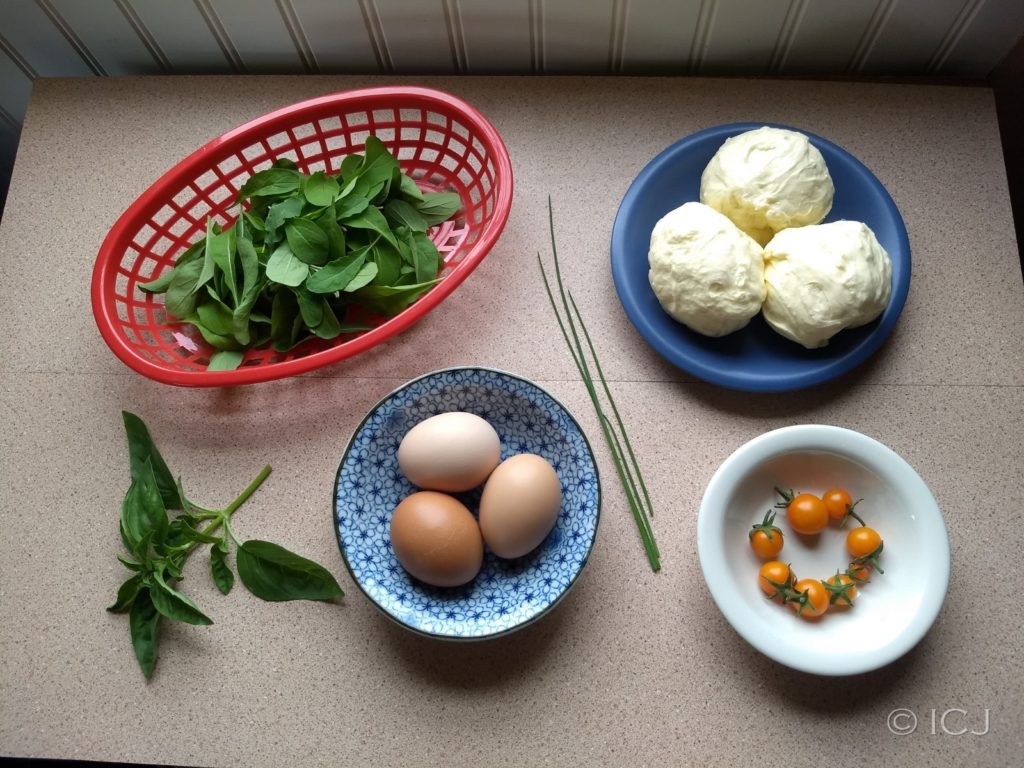
County breakfast just got a whole lot more exciting! April, May, and June were scrambled eggs. One could go a long while on farm-fresh scrambled eggs for breakfast but it’s fun to be able to jazz it up. The recipe made 4 balls of cheese. I had eaten one the previous day. I put half of one into the omelet. Displaying all three because it looks more impressive that way.
Eggs (Cryptid Creek, 100 yards), homemade fresh mozzarella cheese (milk from Glenoma, potions from Italy via Homesteader’s Supply). Arugula, basil, chives, and tomatoes all homegrown. Second-run apple juice (homegrown). I drank most of the coffee while prepping everything else.

Snack #1: Cherries and Chocolate
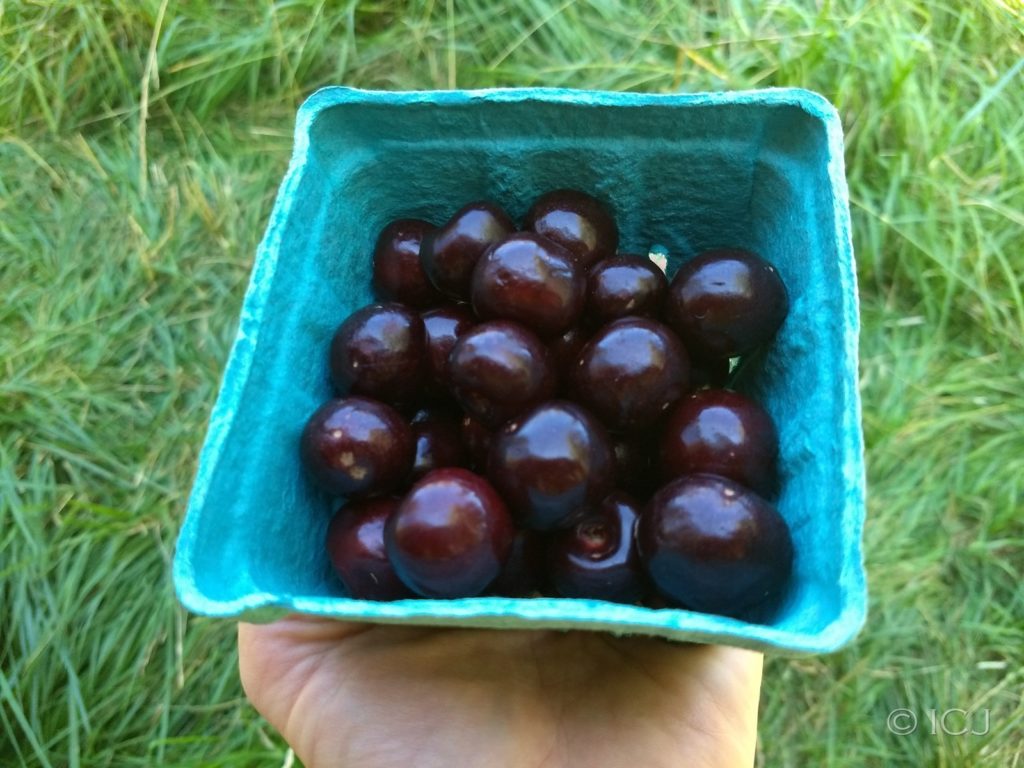
Cherries from the Chehalis farmer’s market. I forget the farm and variety name but they were grown in Lewis County on the west side (of the Cascades–most cherries grown on the east side of the state in the Yakima valley). I ate half the basket of cherries and several squares of chocolate on my way back from errands in town.
Snack #2: Pepino
Cucumber (Chehalis), lime juice, salt. Hold the cayenne, which is the typical 4th ingredient in this dish. We have a Scandinavian palate to accommodate here.

I was introduced to this refreshing Latin American snack when working at Chicago River Canoe & Kayak. The park was in a predominantly Latino neighborhood and was home to a number of community sporting events as well as family picnics. The bicycle-pulled or human-pushed snack carts would come around and we would spend our tip money on soggy paper plates full of ‘pepino’ or on ‘paletas’, the yummy Mexican popsicles that tasted more like decent frozen yogurt than they did the food-colored-test-tube-flavored American kind. Cold corn-on-the-cob, shaved off the cob into a cup and loaded with mayo and cayenne was the third typical offering. I only tried that once.
Snack #3: Milkshake
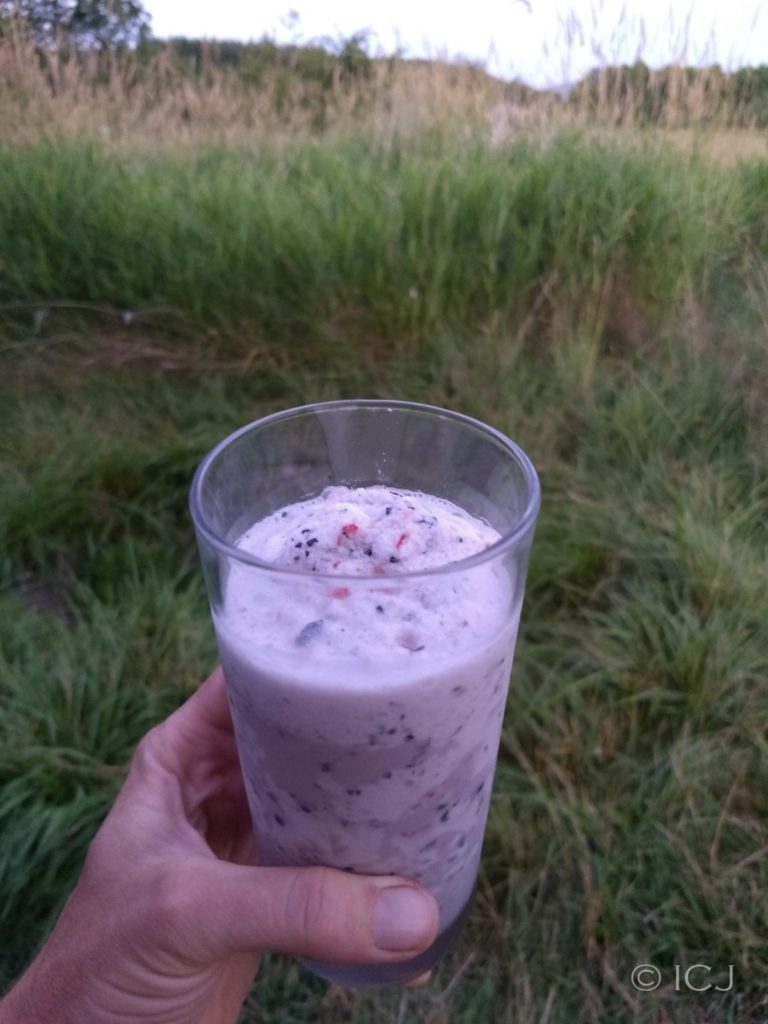
Raw ice cream (see A Cow Named Lu), homegrown strawberries and blueberries. Nomnomnom. The cheese might not clobber the competition but that is a contender for the best milkshake I’ve ever had.
Dinner: Elk Steak, Beets with Greens
Elk steak (Lewis county, shot and butchered by my mechanic and his sons) marinated with olive oil, caramelized shallot (homegrown), homegrown hard cider (=somewhat fermented second-run apple juice), and maple syrup.
Beets from Chehalis Farmer’s Market, root part roasted in toaster oven, greens sauteed.
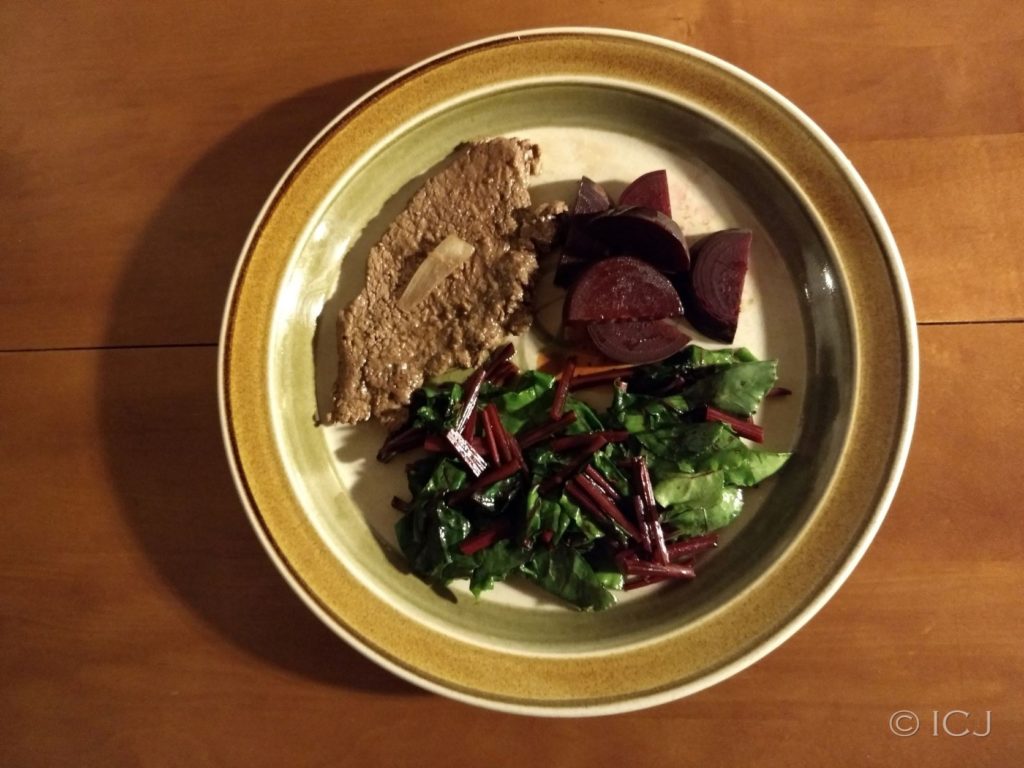
State Foodshed Day – July 28
Prepping the ‘biga’ (Italian for sourdough starter) for the Italian sourdough the afternoon before. I bought a sampler pack (2 lbs each of 5 types) of flour from Bluebird Grain Farms back in April. I’ve had this recipe for ages, back from an Italian-themed party (New Year’s?) in my mid-twenties. I hadn’t tried it in years but it was right there in my recipe folder where I left it.
With standard issue grocery store ‘all-purpose’ flour it’s pretty good. With Bluebird flour it both looks worlds fancier and tastes like it belongs at a vineyard in Tuscany. I have been baking more than half of my own bread for more than half my life now. Just add water, salt, and yeast. Top-notch fresh ingredients + long experience = magic.
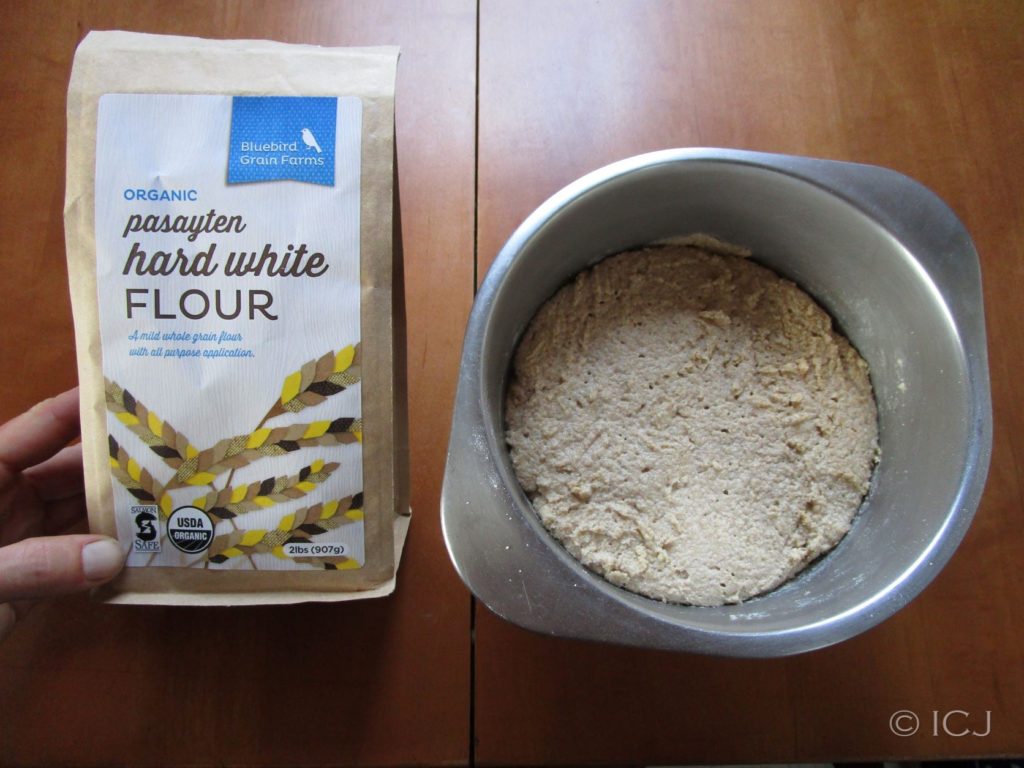
Breakfast: Swedish Pancakes, Coffee
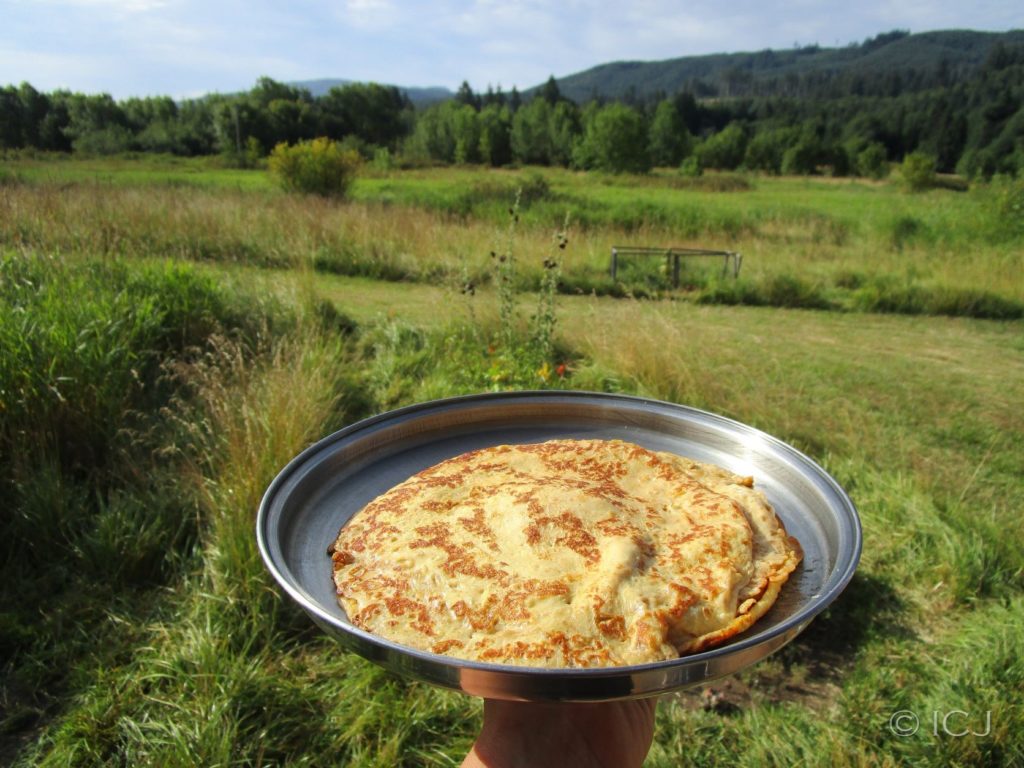
Welcome to Valhalla. Breakfast is served.
I definitely identify as a Viking. The traditional Nordic vision of the afterlife involved fighting all day, dying gloriously in battle (the prerequisite for entry to heaven), being resurrected in the evening, and then indulging in a feast involving pork and mead every night. The pork came from a pig (a wild boar?) that regenerates every day to be slaughtered for the feast.
Nowhere in the mythology does it mention breakfast, at least not that I can remember. That leaves room for poetic license. I am free to imagine that they serve pancakes for breakfast in Valhalla every day. What kind of heaven would it be if it were otherwise? Kom igen nu. (Come on, now . . .)
A single batch of my family’s Swedish pancake recipe typically serves three, even if those three are my nieces and nephew at ages 2, 2, and 4. Those children can put some pancakes away. Miniature Vikings. Rarely do I make Swedish pancakes for anything other than a family gathering but this particular morning I let myself move slow, reveling in the production and the results.
As eating well is much of my purpose in undertaking Edgewild Farm, it would be foolish not to take the time to savor my meals and my place now and then. The Foodshed Challenge has been good for helping me take the time to do so. My family on road trips likes to say, “This would be really cool if it were in Europe!” The view from my front porch–meals that I prepared and partially grew, that originated in my state of residence grown by people who love the land and care about food . . . so grateful.
So grateful to be able to live this way, to have these moments, that I’m tearing up as a write this. It has been such a hard year. I’m lonely. I’m tired. Lots of things are not going according to plan. Everything is getting more expensive so fast that the cost of materials will set me back months or years on projects instrumental to my vision here. But I wake up every morning to this place that is beautiful for anywhere. I have enough to eat and almost every day I eat something delicious even if I don’t spend this much time to make it beautiful. As long as I live I will never run out of good work to do. Yes things are incomplete but my plate is so very full.

That is definitely going to be the calendar photo for July.
Pancakes: eggs (Cryptid Creek, Mossyrock), milk (Thelma the Cow, Glenoma), einkorn flour (Bluebird Grain Farms, Winthrop), maple syrup, salt. Strawberries and blueberries homegrown. Cooked in butter with maple syrup on top.
Snack #1: Bread and Cheese
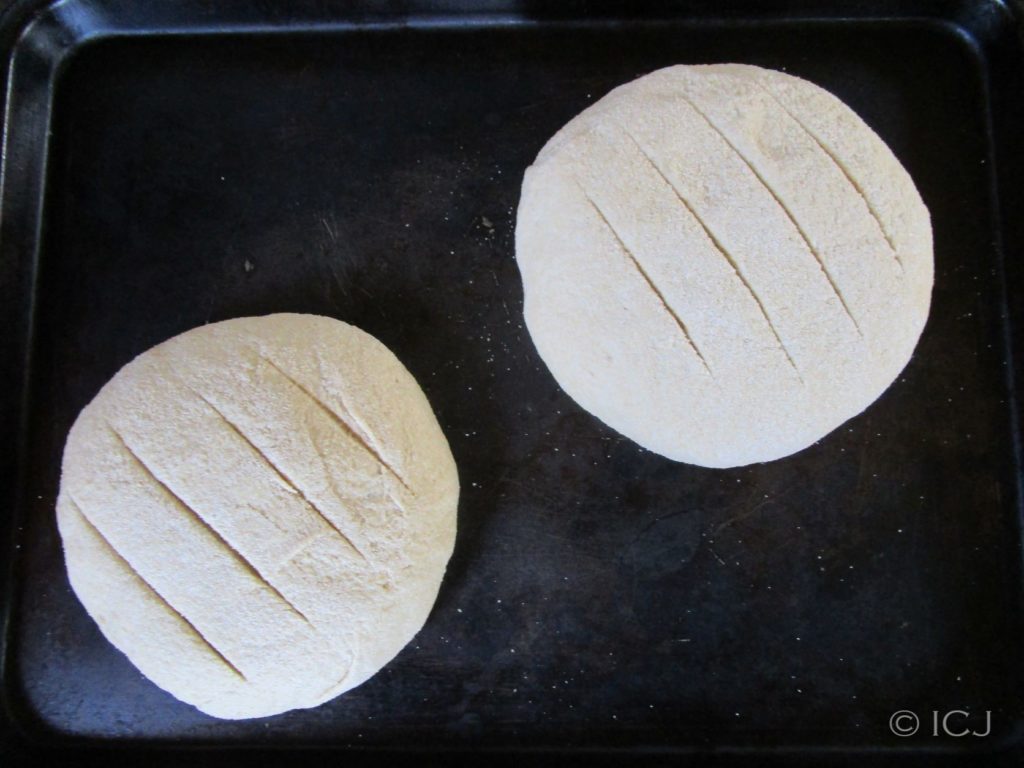
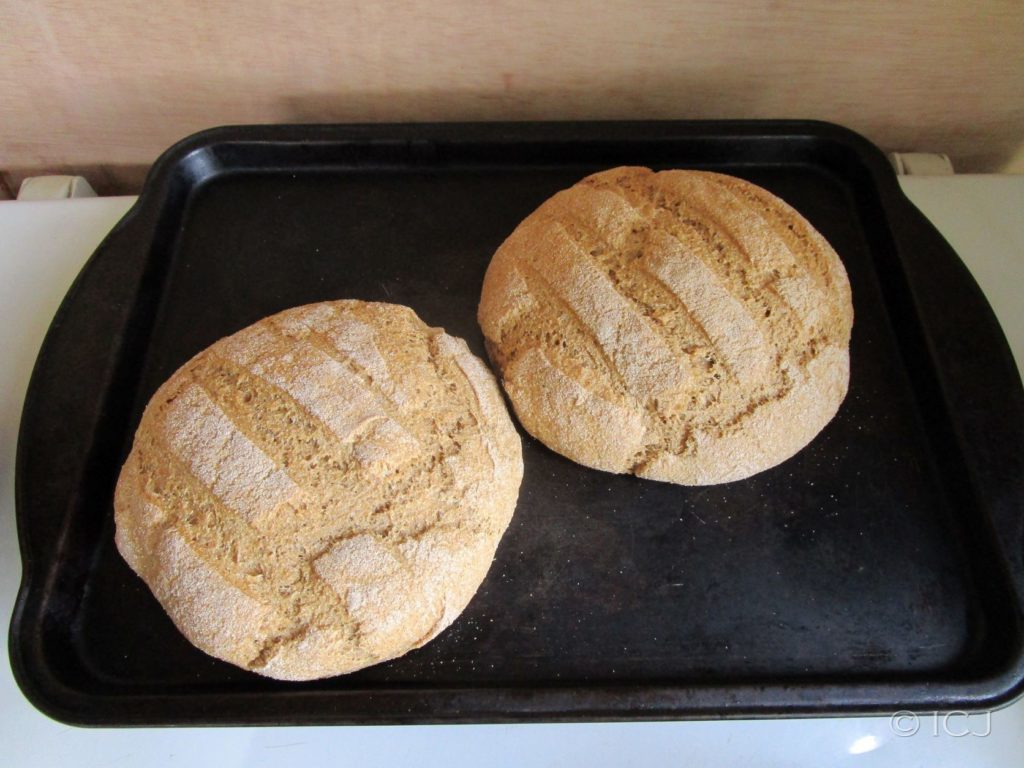
Dough rising. Bread fresh out of oven. Just add butter and and a wedge of homemade dry mozzarella (milk from Thelma of Glenoma, potions from Italy via Homesteader’s Supply).
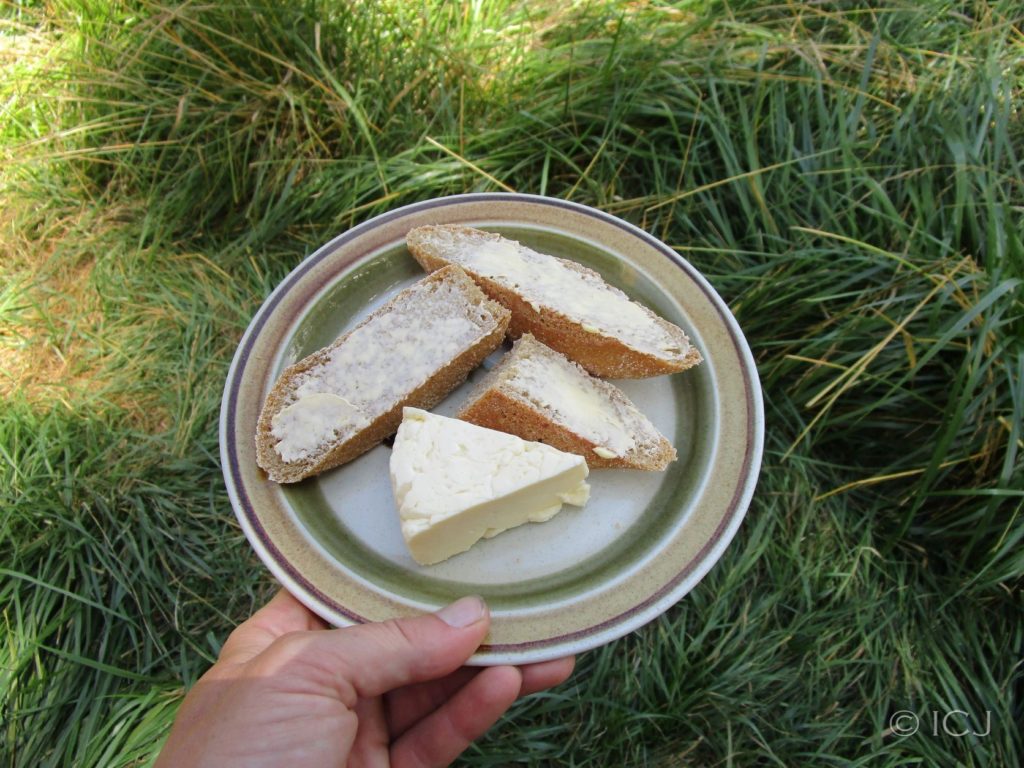
Lunch: Bruschetta, Cucumber, Tomato
Homemade Italian sourdough drizzled with olive oil and toasted with Cherokee Purple tomato (homegrown), homemade mozzarella. Basil (homegrown) on top after toasting, with another Cherokee Purple tomato and a homegrown cucumber on the side. This would be really cool if it were in Europe.
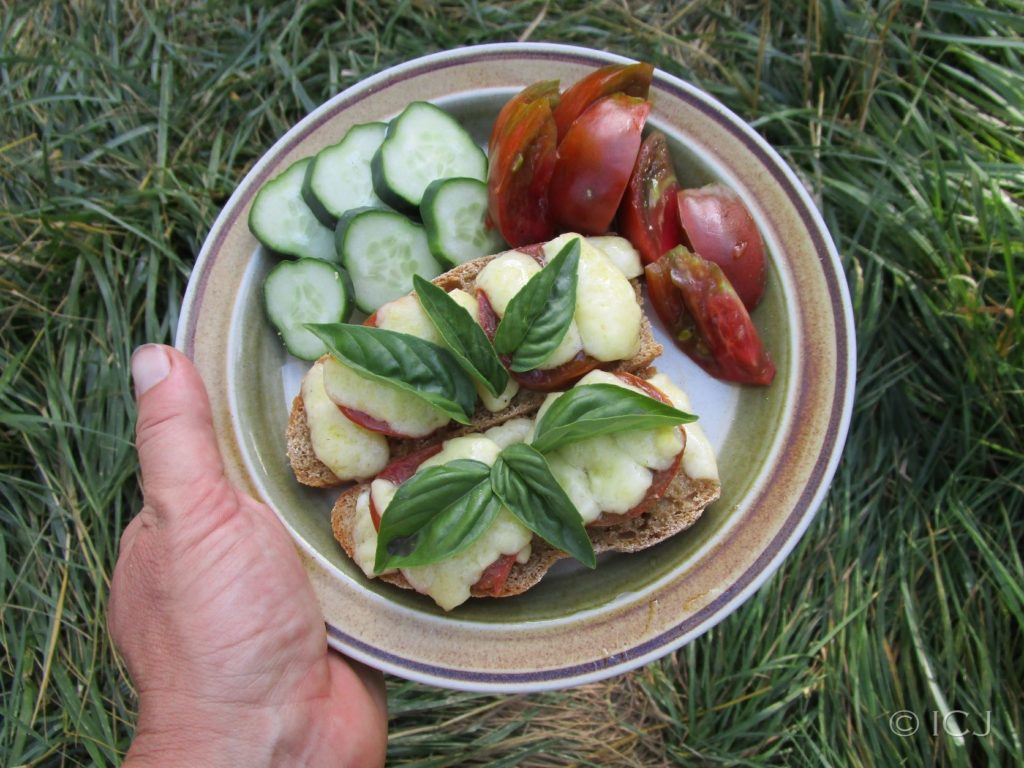
Snack #2 – Raw Ice Cream with Blackberries
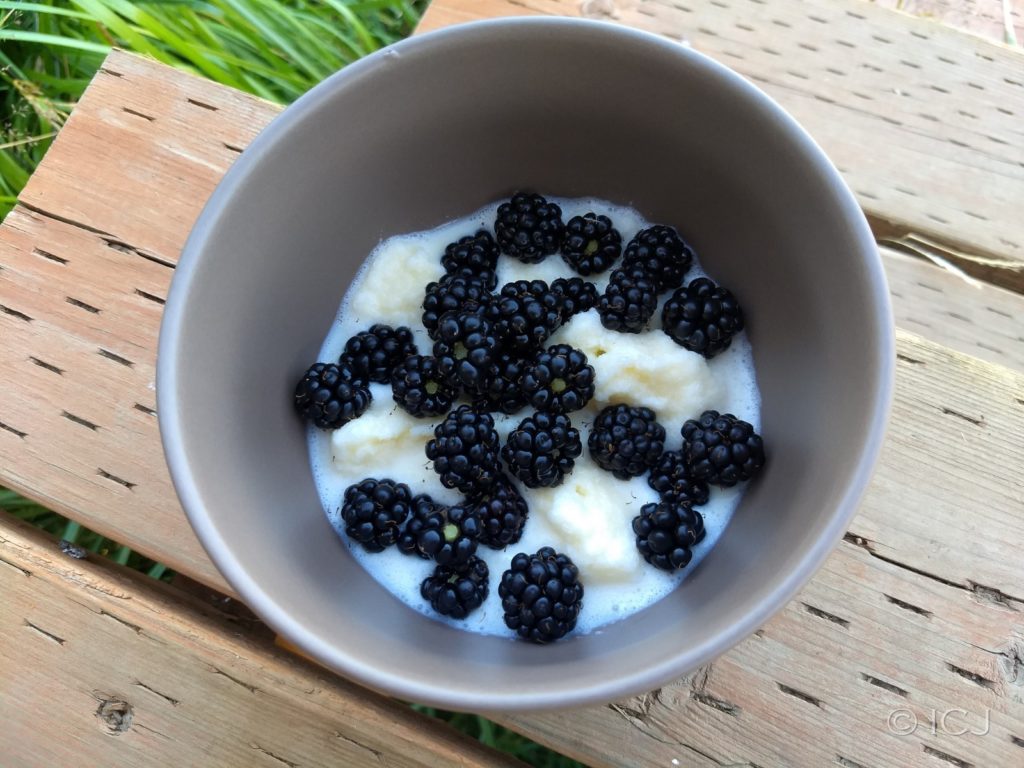
I thought the blackberries might do poorly this year on account of heat and drought like the ones in the Seattle area did after the un-winter of 2015 and subsequent hot dry summer. Not at all. If anything they were better than last year. I think their roots go down to the underworld and that they are as immortal as Valhalla’s boar.
Raw ice cream: milk (Glenoma), honey (Beeworks, Bellingham), egg (Cryptid Creek, Mossyrock), vanilla, salt.
Dinner: Meatballs, Potatoes, Cabbage
Swedish meatballs left from State Food Day in April. Potatoes (boiled with a little butter and salt on top) and cabbage (just sliced raw) from Piece by Piece farm in Olympia. In-house cuisine flight Sweden to Italy and back to Sweden again. Good day.
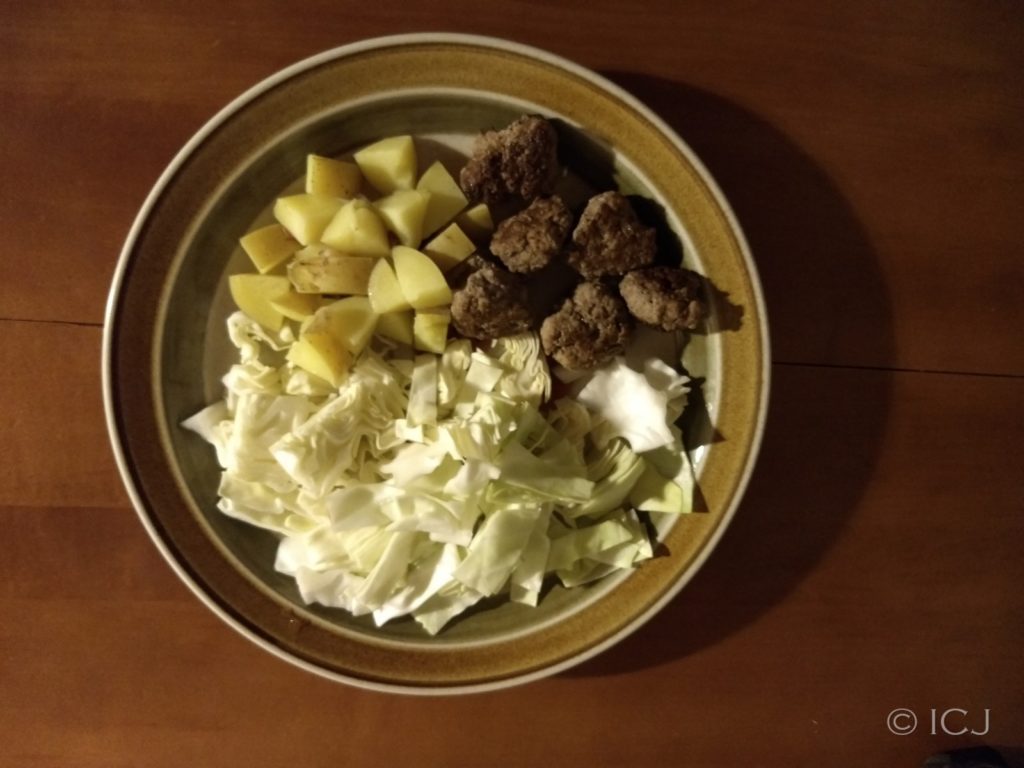
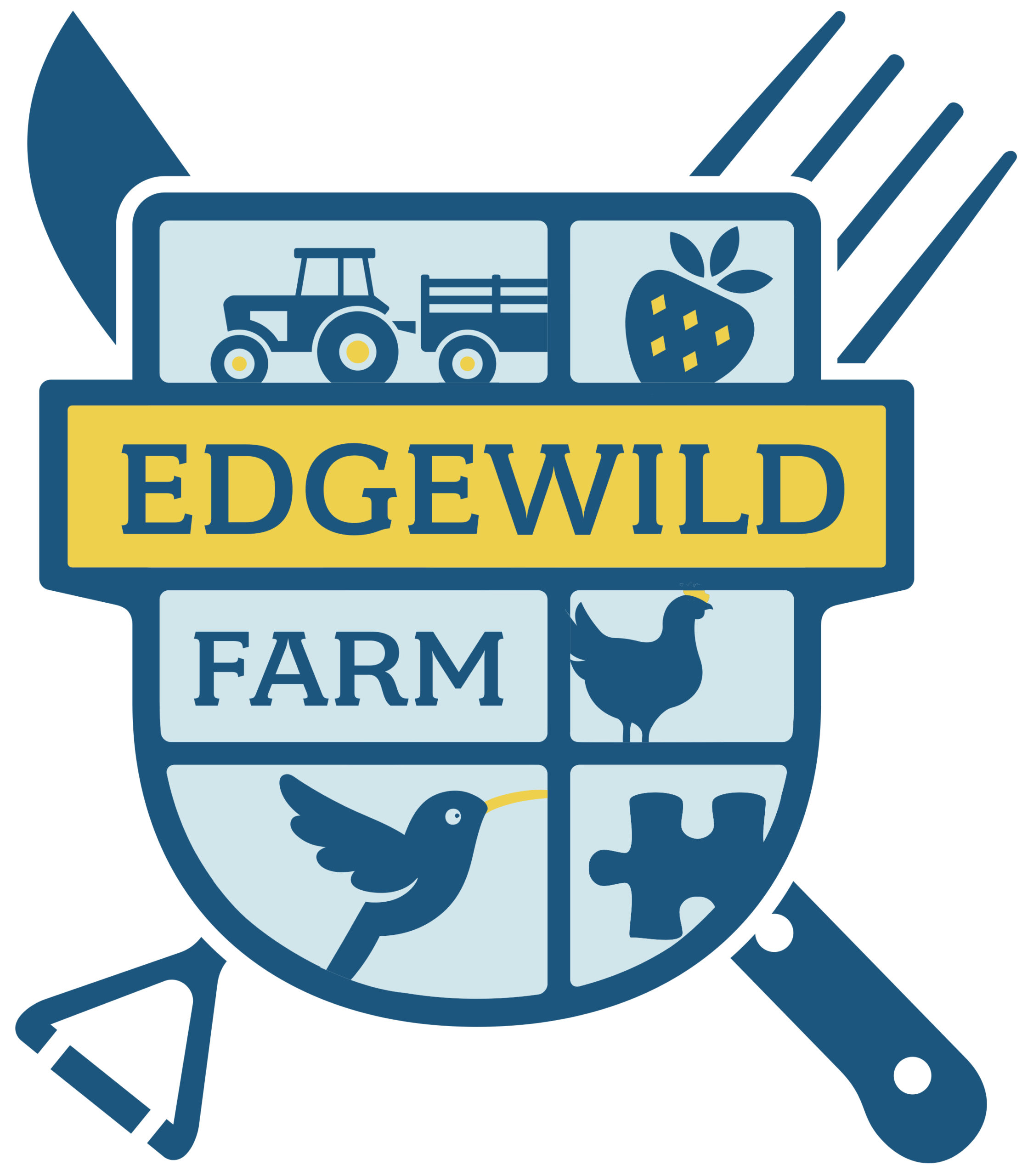
Love your pics and posts! You too!